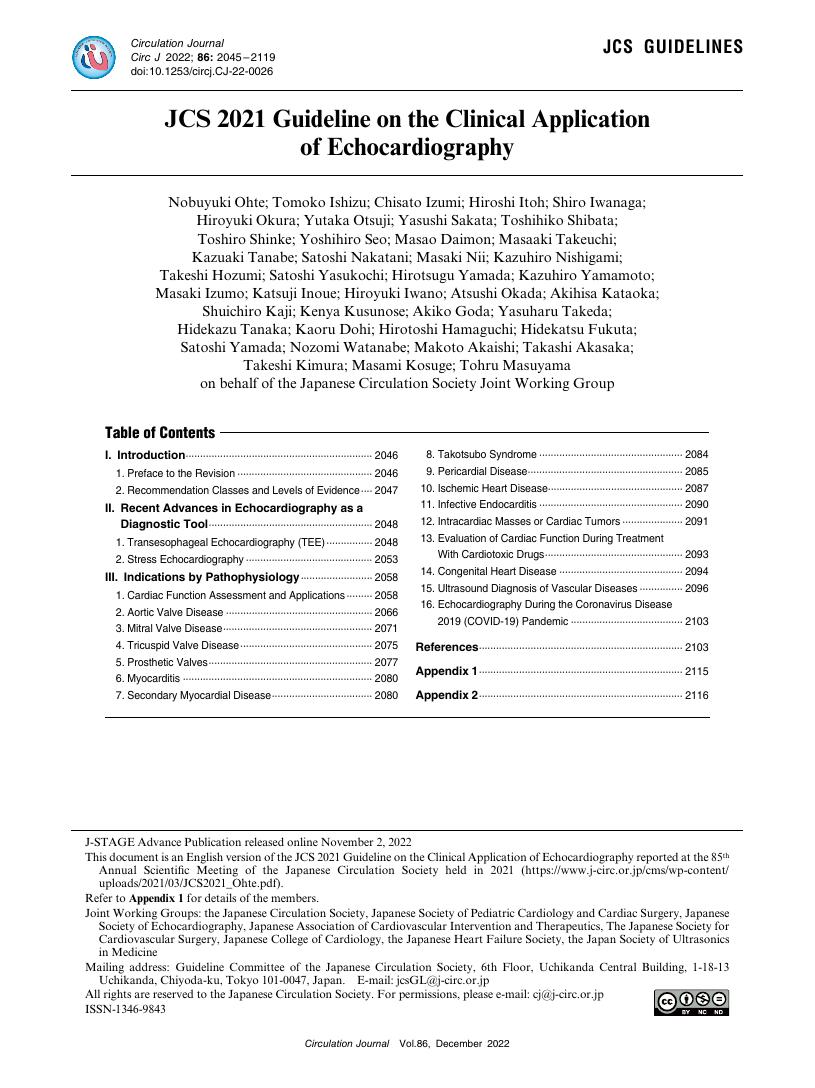- 著者
- Nobuyuki Ohte Tomoko Ishizu Chisato Izumi Hiroshi Itoh Shiro Iwanaga Hiroyuki Okura Yutaka Otsuji Yasushi Sakata Toshihiko Shibata Toshiro Shinke Yoshihiro Seo Masao Daimon Masaaki Takeuchi Kazuaki Tanabe Satoshi Nakatani Masaki Nii Kazuhiro Nishigami Takeshi Hozumi Satoshi Yasukochi Hirotsugu Yamada Kazuhiro Yamamoto Masaki Izumo Katsuji Inoue Hiroyuki Iwano Atsushi Okada Akihisa Kataoka Shuichiro Kaji Kenya Kusunose Akiko Goda Yasuharu Takeda Hidekazu Tanaka Kaoru Dohi Hirotoshi Hamaguchi Hidekatsu Fukuta Satoshi Yamada Nozomi Watanabe Makoto Akaishi Takashi Akasaka Takeshi Kimura Masami Kosuge Tohru Masuyama on behalf of the Japanese Circulation Society Joint Working Group
- 出版者
- The Japanese Circulation Society
- 雑誌
- Circulation Journal (ISSN:13469843)
- 巻号頁・発行日
- vol.86, no.12, pp.2045-2119, 2022-11-25 (Released:2022-11-25)
- 参考文献数
- 460
- 被引用文献数
- 16
- 著者
- Chuwa Tei Teruhiko Imamura Koichiro Kinugawa Teruo Inoue Tohru Masuyama Hiroshi Inoue Hirofumi Noike Toshihiro Muramatsu Yasuchika Takeishi Keijiro Saku Kazumasa Harada Hiroyuki Daida Youichi Kobayashi Nobuhisa Hagiwara Masatoshi Nagayama Shinichi Momomura Kazuya Yonezawa Hiroshi Ito Satoshi Gojo Makoto Akaishi Masaaki Miyata Mitsuru Ohishi WAON-CHF Study Investigators
- 出版者
- 日本循環器学会
- 雑誌
- Circulation Journal (ISSN:13469843)
- 巻号頁・発行日
- pp.CJ-16-0051, (Released:2016-03-18)
- 参考文献数
- 32
- 被引用文献数
- 42
Background:Waon therapy improves heart failure (HF) symptoms, but further evidence in patients with advanced HF remains uncertain.Methods and Results:In 19 institutes, we prospectively enrolled hospitalized patients with advanced HF, who had plasma levels of B-type natriuretic peptide (BNP) >500 pg/ml on admission and BNP >300 pg/ml regardless of more than 1 week of medical therapy. Enrolled patients were randomized into Waon therapy or control groups. Waon therapy was performed once daily for 10 days with a far infrared-ray dry sauna maintained at 60℃ for 15 min, followed by bed rest for 30 min covered with a blanket. The primary endpoint was the ratio of BNP before and after treatment. In total, 76 Waon therapy and 73 control patients (mean age 66 years, men 61%, mean plasma BNP 777 pg/ml) were studied. The groups differed only in body mass index and the frequency of diabetes. The plasma BNP, NYHA classification, 6-min walk distance (6MWD), and cardiothoracic ratio significantly improved only in the Waon therapy group. Improvements in NYHA classification, 6MWD, and cardiothoracic ratio were significant in the Waon therapy group, although the change in plasma BNP did not reach statistical significance. No serious adverse events were observed in either group.Conclusions:Waon therapy, a holistic soothing warmth therapy, showed clinical advantages in safety and efficacy among patients with advanced HF.
- 著者
- Chuwa Tei Teruhiko Imamura Koichiro Kinugawa Teruo Inoue Tohru Masuyama Hiroshi Inoue Hirofumi Noike Toshihiro Muramatsu Yasuchika Takeishi Keijiro Saku Kazumasa Harada Hiroyuki Daida Youichi Kobayashi Nobuhisa Hagiwara Masatoshi Nagayama Shinichi Momomura Kazuya Yonezawa Hiroshi Ito Satoshi Gojo Makoto Akaishi Masaaki Miyata Mitsuru Ohishi WAON-CHF Study Investigators
- 出版者
- 日本循環器学会
- 雑誌
- Circulation Journal (ISSN:13469843)
- 巻号頁・発行日
- vol.80, no.4, pp.827-834, 2016-03-25 (Released:2016-03-25)
- 参考文献数
- 32
- 被引用文献数
- 42
Background:Waon therapy improves heart failure (HF) symptoms, but further evidence in patients with advanced HF remains uncertain.Methods and Results:In 19 institutes, we prospectively enrolled hospitalized patients with advanced HF, who had plasma levels of B-type natriuretic peptide (BNP) >500 pg/ml on admission and BNP >300 pg/ml regardless of more than 1 week of medical therapy. Enrolled patients were randomized into Waon therapy or control groups. Waon therapy was performed once daily for 10 days with a far infrared-ray dry sauna maintained at 60℃ for 15 min, followed by bed rest for 30 min covered with a blanket. The primary endpoint was the ratio of BNP before and after treatment. In total, 76 Waon therapy and 73 control patients (mean age 66 years, men 61%, mean plasma BNP 777 pg/ml) were studied. The groups differed only in body mass index and the frequency of diabetes. The plasma BNP, NYHA classification, 6-min walk distance (6MWD), and cardiothoracic ratio significantly improved only in the Waon therapy group. Improvements in NYHA classification, 6MWD, and cardiothoracic ratio were significant in the Waon therapy group, although the change in plasma BNP did not reach statistical significance. No serious adverse events were observed in either group.Conclusions:Waon therapy, a holistic soothing warmth therapy, showed clinical advantages in safety and efficacy among patients with advanced HF. (Circ J 2016; 80: 827–834)
- 著者
- Takashi Akima Katsutoshi Sekine Koki Yamaoka Yuta Seki Kazuaki Nakajima Masahito Munakata Hideaki Kanki Makoto Akaishi Takashi Koyama
- 出版者
- The Japanese Circulation Society
- 雑誌
- Circulation Reports (ISSN:24340790)
- 巻号頁・発行日
- vol.2, no.11, pp.657-664, 2020-11-10 (Released:2020-11-10)
- 参考文献数
- 22
- 被引用文献数
- 1
Background:The relationship between left ventricular diastolic dysfunction (LVDD) and paroxysmal atrial fibrillation (PAF) remains unclear because of a lack of standard measures to evaluate LVDD. Accordingly, we examined the association between the prevalence of PAF and each LVDD grade determined according to the latest American Society of Echocardiography guidelines.Methods and Results:In all, 2,063 patients without persistent AF who underwent echocardiography at Saitama Municipal Hospital from July 2016 to June 2017 were included in the study. Patients were divided into LVDD 6 categories: No-LVDD (n=1,107), Borderline (n=392), Grade 1 (n=204), Indeterminate (n=62), Grade 2 (n=254), and Grade 3 (n=44). PAF was documented in 111 (10.0%), 81 (20.7%), 28 (13.7%), 6 (9.7%), 52 (20.5%), and 24 (54.5%) patients in the No-LVDD, Borderline, Grade 1, Indeterminate, Grade 2, and Grade 3 categories, respectively. PAF prevalence was higher in patients with Grade 3 LVDD across the whole study population. Subgroup analyses showed that the prevalence of PAF increased with increased LVDD grade in patients with reduced left ventricular ejection fraction. This relationship was significant in multivariate analysis including various patient characteristics.Conclusions:LVDD severity determined on the basis of the latest echocardiographic criteria was associated with the prevalence of PAF. The present findings shed light on the development of new therapeutic markers for PAF.
